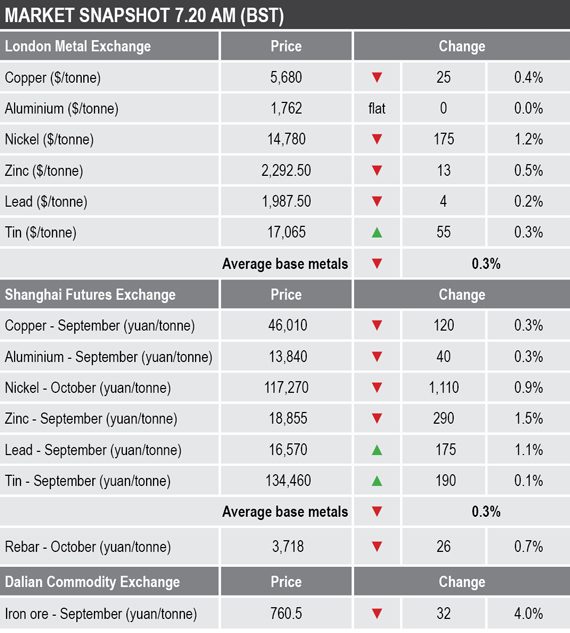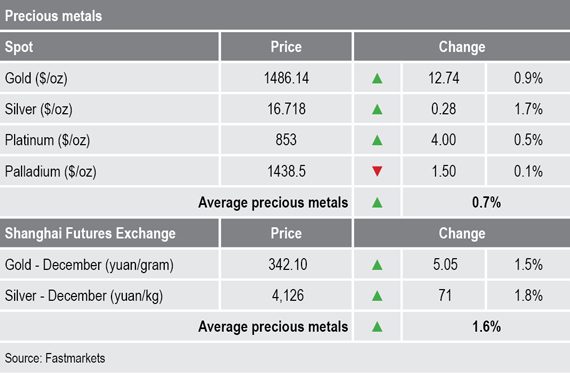Equities in Asia were mixed on Wednesday August 7 after a mixed performance in western markets on Tuesday, but more central banks are cutting rates with the reserve banks of India and New Zealand doing so by 35 and 50 basis points respectively.
- Gold price reaches fresh high of $1,491.30 per oz.
- Glencore is once again being proactive by announcing cuts to copper and cobalt production, starting 2020.
Base metals
On the London Metal Exchange, three-month base metals prices were for the most part weaker on Wednesday with copper, nickel, lead and zinc down by an average of 0.6%, while aluminium was unchanged and tin was up by 0.3%. Copper was recently quoted at $5,680 per tonne, holding just above Monday’s low at $5,640 per tonne. Lead and nickel are the only base metals holding up nearer to recent highs than the lows.
In China, base metals prices on the Shanghai Futures Exchange were mixed. September lead bucked the trend with a 1.1% rise, September tin was little changed, while the rest of the complex were down by between 0.3% for October copper and September aluminium and 1.5% for October zinc.
Spot copper prices in Changjiang were up by 0.2% at 46,040-46,200 yuan per tonne and the LME/Shanghai copper arbitrage ratio was stronger at 8.10 compared with 7.95 on Friday – the rise in the ratio suggesting LME copper prices have been harder hit than those in Shanghai.
Precious metals
Spot gold continues to rise while haven demand grows, with prices closing in on $1,500 per oz after reaching a high of $1.491.30 per oz. Silver has followed gold’s lead, with prices rising to a high of $16.80 per oz, while the platinum group metals are consolidating after recent weakness.
On the SHFE, the December gold and silver contracts were up by 1.5% and 1.8% respectively.
Wider markets
The spot Brent crude oil price is trending lower again and was recently quoted at $58.70 per barrel, this is the lowest it has been since early January, and is a sure sign that economic woes have overtaken the geopolitical standoff in over Iran.
The yield on benchmark US 10-year treasuries continues to collapse while haven demand increases, it was recently quoted at 1.6875% compared with 1.8866% at a similar time on August 2. The German 10-year bund yield continues to weaken too – it was recently at -0.5540% compared with -0.4840% on August 2.
In equities, Asian indices were largely down: Nikkei (-0.33%), Hang Seng (+0.07%), Kospi (-0.41%) and the CSI 300 (-0.41%), but the ASX200 (+0.64%) showed some strength.
This follows a mixed performance in western markets on Tuesday; In the United States the Dow Jones Industrial Average closed up by 1.21% at 26,029.52 and in Europe the Euro Stoxx50 closed down by 0.58% at 3,291.66.
Currencies
The dollar index reached a high of 98.94 on August 1, but it has since dropped back to 97.60. The weakness in treasury yields and equities seems to be becoming a headwind for the dollar and that has seen some diversification into the Japanese yen (106.21) and euro (1.1200).
But the Australian dollar (0.6719) is weaker, while sterling (1.2178) is consolidating in low ground.
Key data
Economic data already out Wednesday, shows German industrial production fell 1.5% in June, compared with a 0.1% fall in May.
Later there is data out on UK house prices and US crude oil inventories and consumer credit. In addition, US Federal Open Market Committee member Charles Evans is speaking.
Today’s key themes and views
The base metals have taken the latest standoff in the US-China trade talks badly, especially as this has escalated the tariff wars. In this environment it is hardly surprising traders are putting fundamentals to the back of their minds – even Glencore’s announcement that it will cut 200,000 tonnes of copper production at its Mutanda mine in the Democratic Republic of the Congo next year has hardly had an effect. We should remember that back in 2015, Glencore was one of the most proactive miners in making cutbacks and that started to underpin sentiment in the market.
Gold is doing what gold should do in such times, it is providing a haven and the fact the opportunity cost of holding gold is continuing to fall, is no doubt helping.



